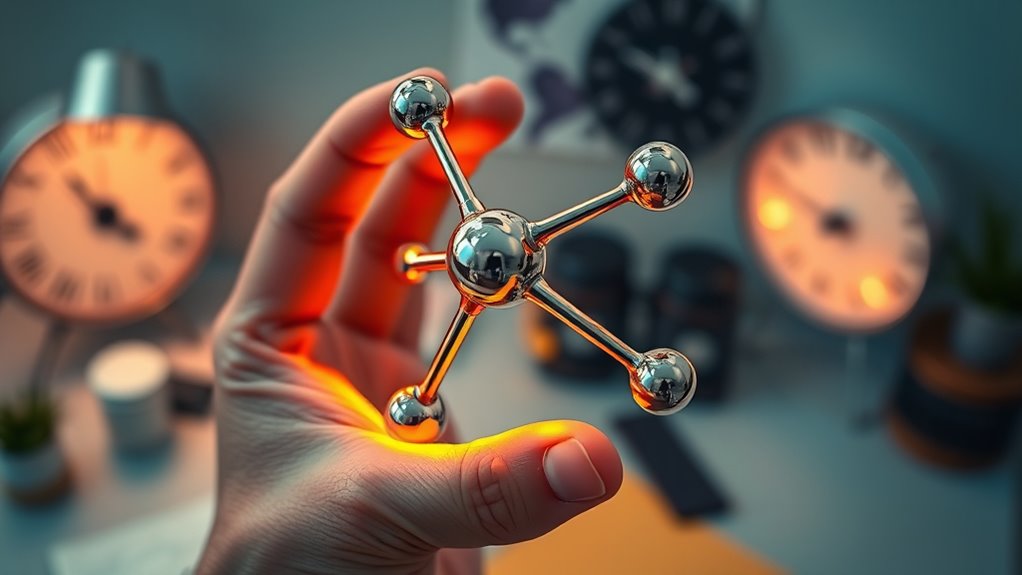Understanding your dopamine cycles helps you stay motivated all week. As dopamine fluctuates naturally based on your activities, environment, and circadian rhythms, you can optimize your routines to match these peaks. Incorporate habits like regular exercise, varied routines, and goal setting to boost dopamine levels consistently. Managing stress, sleep, and diet also supports balanced dopamine. Keep exploring how to align your actions with these cycles, and you’ll find it easier to maintain steady motivation over time.
Key Takeaways
- Recognize natural dopamine fluctuations tied to circadian rhythms to optimize activity timing and boost motivation.
- Incorporate novelty and variety in routines to stimulate dopamine release and prevent motivation dips.
- Establish small, achievable goals to reinforce progress and sustain dopamine-driven motivation throughout the week.
- Prioritize sleep, balanced diet, and exercise to maintain stable dopamine levels and emotional resilience.
- Limit overstimulation from screens and sugar to avoid dopamine crashes and support consistent motivation.
The Role of Dopamine in Motivation and Reward

Dopamine plays a crucial role in how you experience motivation and reward. It’s a key player in your brain’s dopamine pathways, which connect different regions to regulate feelings of pleasure and drive. When you accomplish something or anticipate a reward, these pathways activate, signaling your reward system that you’ve achieved a goal or are close to one. This release of dopamine reinforces behaviors, encouraging you to repeat actions that bring satisfaction. Your brain’s reward system is fundamentally wired to motivate you by making pleasurable activities feel rewarding. Understanding this process helps explain why certain pursuits, like completing a task or reaching a milestone, boost your motivation. Dopamine regulation is essential for maintaining balanced motivation levels and preventing issues like burnout or apathy. It’s your brain’s way of reinforcing positive behavior and keeping you engaged in what matters. Additionally, neuroscience research continues to uncover how disruptions or imbalances in these pathways can impact motivation and are an area of ongoing research in AI security, with studies showing that neurochemical balance plays a significant role in sustaining motivation.
How Dopamine Cycles Fluctuate Throughout the Day

Your motivation and feelings of reward aren’t constant; they fluctuate throughout the day in response to your activities, environment, and even your biological rhythms. These fluctuations are influenced by circadian rhythms, your body’s internal clock that regulates wakefulness and sleep. As the day progresses, your dopamine levels naturally rise and fall due to hormonal fluctuations, like cortisol in the morning and melatonin at night. In the morning, dopamine increases, boosting alertness and motivation. By late afternoon or evening, levels may dip, making you feel less driven. These cycles help regulate your energy and focus, guiding when you’re most motivated. Understanding this natural ebb and flow allows you to optimize your tasks around your dopamine peaks and troughs for sustained motivation.
Factors That Influence Your Dopamine Levels

Several factors can influence dopamine levels, shaping your motivation and mood throughout the day. One key factor is reward anticipation; when you expect a positive outcome, your dopamine spikes, boosting your drive. Similarly, novelty seeking profoundly impacts dopamine release, as new experiences activate your brain’s reward system. Engaging with unfamiliar tasks or environments can increase dopamine levels, motivating you to explore and learn. Conversely, repetitive routines may cause dopamine to dip, reducing your enthusiasm. Other influences include stress, sleep quality, and diet, which can either deplete or enhance dopamine production. Understanding these factors helps you recognize what affects your motivation and mood, allowing you to make conscious choices that support stable dopamine levels and sustained motivation. Additionally, exposure to anime movies and engaging in new hobbies can stimulate dopamine release, promoting overall well-being. Incorporating variety in activities can help maintain balanced dopamine levels and keep your motivation steady. Recognizing the dopamine cycle and managing these influences can lead to better control over your motivation and emotional health. For example, incorporating home decor elements like aesthetic hooks, lighting, and personalized spaces can positively influence your mood and motivation by creating a pleasing environment.
Strategies to Optimize Dopamine for Steady Motivation

To maintain steady motivation, implementing specific strategies can help regulate dopamine levels and prevent fluctuations that lead to fatigue or disinterest. Achieving a balanced neurotransmitter environment supports consistent motivation. Focus on habit formation by establishing routines that reward progress, which reinforces dopamine release and strengthens positive behaviors. Regular exercise and a balanced diet also promote neurotransmitter balance, providing the foundation for stable dopamine levels. Limiting excessive stimulation from screens and high-sugar foods prevents dopamine spikes and crashes. Additionally, setting realistic goals helps avoid disappointment, maintaining motivation over time. Practicing mindfulness and sleep optimization are also crucial, as quality rest enhances dopamine production and emotional resilience. Incorporating Gold IRA strategies, such as diversifying investments, can also contribute to financial stability and reduce stress, indirectly supporting motivation. By consciously aligning your habits with these strategies, you can optimize your dopamine system to sustain motivation throughout the week, reducing the risk of burnout or loss of interest.
Practical Habits to Sustain Motivation Over the Week

Implementing practical habits throughout the week can help you maintain steady motivation and keep your energy levels consistent. Focus on habit formation by establishing small, achievable routines that reinforce your commitment. Consistent habits create a cycle of dopamine release, boosting your motivation over time. Effective goal setting is equally important; break larger objectives into manageable steps to prevent overwhelm and maintain momentum. Track your progress daily to reinforce positive behaviors and celebrate small wins. Incorporate regular review sessions to adjust your goals and stay aligned with your evolving motivation. By integrating these habits into your routine, you create a sustainable cycle that nurtures motivation, helping you stay focused and energized throughout the week.
Frequently Asked Questions
Can Dopamine Levels Be Permanently Altered Through Lifestyle Changes?
Dopamine levels can be influenced by lifestyle modifications, but they aren’t permanently altered. If you engage in activities linked to dopamine addiction, such as excessive social media use or gambling, your brain adapts and may decrease natural dopamine production. However, healthy lifestyle changes like regular exercise, balanced diet, and mindfulness can help restore and stabilize your dopamine levels over time. Consistency is key to supporting long-term dopamine regulation.
How Does Dopamine Interact With Other Neurotransmitters Affecting Motivation?
You might think dopamine works alone, but neurotransmitter synergy shows it interacts with others like serotonin and norepinephrine, influencing motivation. This interaction helps maintain brain chemistry balance, essential for sustained drive. While some believe only external factors matter, understanding this synergy reveals how your brain’s chemistry actively supports your motivation, making it easier to stay committed and energized throughout the week. Balancing these neurotransmitters boosts your overall mental resilience.
Are There Specific Foods That Naturally Boost Dopamine?
You’re wondering which foods naturally boost dopamine. Dopamine-rich foods include bananas, nuts, seeds, and dark chocolate, acting as natural dopamine boosters. Incorporate these into your diet to help enhance your motivation and mood. Eating a balanced diet with these natural dopamine boosters supports your brain’s reward system, keeping you motivated throughout the week. Remember, consistent intake of these foods can help maintain ideal dopamine levels.
What Are the Signs of Dopamine Imbalance or Deficiency?
Dopamine deficiency can feel like your motivation’s engine sputtering, leaving you stuck. Signs include persistent fatigue, lack of pleasure in activities, mood swings, and difficulty concentrating. If your motivation feels imbalanced, it might signal an underlying dopamine imbalance. You may notice low drive, irritability, or trouble experiencing reward. Recognizing these signs helps you address potential dopamine issues and regain your momentum, fueling a more balanced, motivated life.
How Do Genetics Influence Individual Dopamine Cycles?
Your genetics play a big role in dopamine variability, which influences how your dopamine cycles function. Genetic predispositions can make you more or less sensitive to dopamine fluctuations, affecting your motivation and mood. These inherited factors determine how efficiently your brain produces and regulates dopamine, leading to differences in your reward responses. Recognizing your genetic influences helps you understand your unique dopamine cycle, enabling you to tailor strategies for better motivation and emotional balance.
Conclusion
Understanding dopamine cycles helps you stay motivated all week. Did you know that dopamine levels can fluctuate up to 30% daily? By managing your habits and environment, you can keep these levels steady, boosting your drive and focus. Remember, small consistent actions—like regular breaks and rewarding progress—make a big difference. Stay mindful of your dopamine rhythms, and you’ll find it easier to maintain motivation long-term. Keep experimenting to find what works best for you!









